National Emblem
The National Emblem of Bhutan is a circle, projecting a double diamond thunderbolt placed above the lotus. There is a jewel on all sides with two dragons on the vertical side. The thunderbolt represents the harmony between secular and religious power while the lotus symbolizes purity. The jewel signifies the sovereign power while the dragons (male and female) stand for the name of the country Druk Yul or the Land of the Dragon.
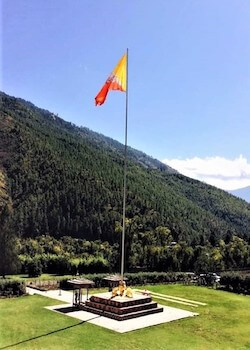 National Flag
National Flag
The National Flag is rectangular in shape that is divided into two parts diagonally. The upper yellow half signifies the secular power and authority of the King while the lower saffron orange symbolises the practice of religion and power of Buddhism, manifested in the traditions of Drukgpa Kagyu. The Dragon signifies the name and purity of the country while the jewels in the claws stand for the wealth and perfection of the country.
National Tree
The national tree is Cypress (Cupressus torolusa), found in temperate climate zone between 1,800 and 3,500 meters. Its capacity to survive on rugged harsh terrain is compared to bravery and simplicity. Bhutanese consider Cypress as a sacred tree and hold it in great reverence. It is often planted outside the monasteries, Dzongs and places of religious significance. Bhutan was once known to Tibetans as 'Lho Mon Tsen Den Jong' (the country of cypress) and the timber from this tree is preferred for building temples, monasteries and Dzongs. It is said that every cypress tree in Bhutan tells a tale and indeed each one has a story. Besides being the national tree of Bhutan, the cypress is also associated with diverse myths and beliefs.
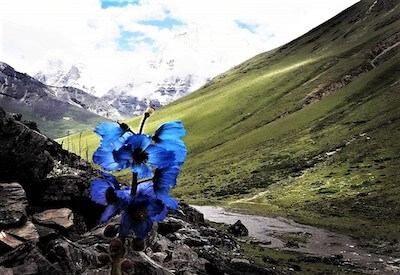 National Flower
National Flower
The National Flower of Bhutan is Blue Poppy (Meconopsis gakyidiana), a delicate blue or purple tinged blossom with a white filament. The Maconopsis gakyidiana is named after the country’s guiding development philosophy of ‘Gross National Happiness’ in which ‘Gakyid’ stands for ‘Happiness’ and ‘diana’ is the term for flower. It grows to a height of one meter, on the rocky mountain terrain and is found above the tree line of 3,000-4,000 meters. This rare plant can live in extreme conditions and its seeds take about two to three years to bloom. Representing simplicity yet with spectacular appearance, each flower just possesses four petals while its blooming time is the annual monsoon season from May to July.
National Bird
Bhutan’s national bird is the Raven and the world’s largest species of blackbirds. The scientific name for Bhutan’s Raven is Corvus Corax Tibetans and it resembles common Crow or Corvus Macrorhynchos. Its shining black feathers, distinctive voice, and playful nature represent power, mystery, wisdom, and intelligence. Known in Bhutan as Legon Jarog Donchen, it represents the deity Gonpo Jarodongchen (raven headed Mahakala), one of the chief guardian deities of Bhutan and is featured prominently in the Raven Crown that is traditionally worn by the reigning Bhutanese Monarch.
The first Raven crown was worn as a battle helmet by the first King, Sir Ugyen Wangchuck’s father Jigme Namgyel (1825-1881) in bloody struggles against rivals including the British who tried unsuccessfully to subdue him. His root Lama and spiritual companion, Jangchub Tsundru (1817-1856), designed the sacred Raven Crown for him. Jigme Namgyel considered the raven helmet his lucky protector, a key to his victory in keeping Bhutan a sovereign nation. Then the first King, Sir Ugyen Wangchuck adopted the crown with the head of a raven as the unique symbol of his authority and ever since then, the Raven Crown has symbolized the lineage of the Kings of Bhutan.
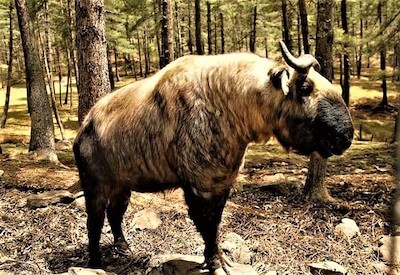 National Animal
National Animal
The Takin (Burdorcas taxicolor) is the national animal of Bhutan, looking like a cross between a cow and goat. Bhutan's Takin is deeply affiliated with Buddhism and has a strong cultural and religious significance. According to a Bhutanese legend, the Takin was miraculously created by embellishing the head of a goat to a body of a cow by the famous Tibetan saint Lama Drukpa Kuenley. Hence, in Bhutanese ethos, Takin holds a special place as an entity of worship and mascot. It was declared as the national animal of the country in 1985 and found along the warm broadleaved forest through the alpine region between the altitudinal range of 1,200 m in warm broadleaved forest and 5,374 m in northern Bhutan.
National Day
17th December is celebrated as the National Day that coincides with the crowing of Gongpa Ugyen Wangchuk as the first hereditary King of Bhutan, in Punakha Dzong on 17 December 1907. This day marks a significant milestone in the evolution of Bhutan as a sovereign nation and heralds a pivotal moment in the psychological and emotional experience of the country and its people. It’s also an occasion to celebrate unprecedented unity, peace and prosperity the country has embraced.
National Anthem
The national anthem was first composed in 1953 and became official in 1966. It is known as Druk Tshenden Kepay Gyalkhab Na and is religious in essence with lyrics consisting of prayers for peace and prosperity in the country, the long life of the King and the propagation of Buddhism.
The English translation of the national anthem is as under:
In the Kingdom of Bhutan adorned with cypress trees,
The Protector who reigns over the realm of spiritual and secular traditions,
He is the King of Bhutan, the precious sovereign.
May His being remain unchanging, and the Kingdom prosper,
May the teachings of the Enlightened One flourish,
May the sun of peace and happiness shine over all people
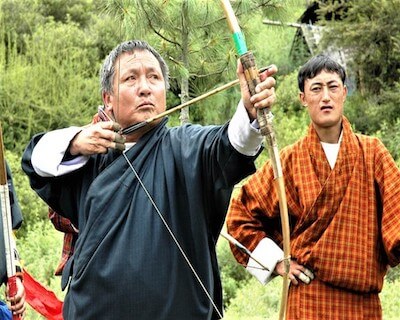 National Sport
National Sport
Archery or ‘Dha’ as it is called in the official language Dzongkha was declared the national sport in 1971 when Bhutan became a member of the United Nations. In Bhutan, every village has its own archery range and high-spirited archery competitions, usually accompanied by a banquet, are a riot of colour and excitement, with two teams in traditional dress shooting at small wooden targets placed 130m apart. During competitions, when an arrow hits the target, teammates perform a celebratory slow-motion dance and sing in the praises of the shooter, who tucks a coloured scarf into his belt. For major tournaments, each team brings its own cheerleading section of girls decked out in their finest clothes who sing and dance when the opposition team attempt to hit a target and try to distract them. Archery tournaments are among the most picturesque and colourful events in the country.
National Language
The state language is Dzongkha which in the olden times was spoken by people who worked in the Dzongs that was the seat of temporal and spiritual power. Later, Dzongkha was declared as the national language of the country. Today, over 19 dialects are spoken all over the country.
Two other major languages spoken in the country are the 'Tshanglakha' (the native language of the Tshanglas, or of people of eastern Bhutan) and the 'Lhotshamkha' (spoken by the southern Bhutanese of Nepali origin). Other dialects spoken are Khengkha and Bumthapkha by the Khengpas and Bumthap, people of Central Bhutan. Mangdepkah, which is spoken by the inhabitants of Trongsa and the Cho Cha Nga Chang Kha which is spoken by the Kurtoeps are the other dialects in the country. The Sherpas, Lepchas and the Tamangs in southern Bhutan also have their own dialects.
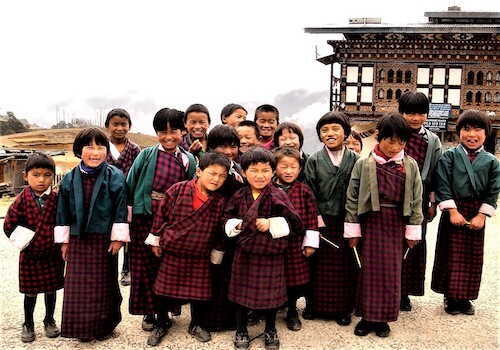 National Dress
National Dress
The national dress of Bhutan is called the 'Gho' for men and 'Kira' for women. It was introduced during the 17th century by Zhabdrung Ngawang Namgyal to give the Bhutanese a unique identity. The Gho is a long robe hoisted to the knee and held in place with a 'Kera,' a woven cloth belt, wound tightly around the waist. The Kira is a floor-length rectangular piece of cloth wrapped around the body over a blouse called Wonju. The Kira is held from the shoulders by broach-like hooks called 'Koma' and is fastened at the waist with a Kera. The dress is complete with a short, open jacket-like garment called 'Toego.'